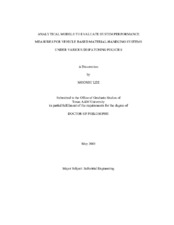| dc.description.abstract | Queueing network-based approximation models were developed to evaluate
the performance of fixed-route material-handling systems supporting a multiple
workcenter manufacturing facility. In this research, we develop analytical models for
fixed-route material-handling systems from two different perspectives: the
workcenters?? point of view and the transporters?? point of view. The state-dependent
nature of the transportation time is considered here for more accurate analytical
approximation models for material-handling systems. Also, an analytical methodology
is developed for analytical descriptions of the impact of several different vehicledispatching
policies for material-handling systems. Two different types of vehicledispatching
policies are considered. Those are workcenter-initiated vehicle
dispatching rules and vehicle-initiated vehicle dispatching rules. For the workcenterinitiated
vehicle dispatching rule, the Closest Transporter Allocation Rule (CTAR)
was used to assign empty transporters to jobs needing to be moved between various
workcenters. On the other hand, four different vehicle-initiated vehicle dispatching
rules, Shortest Distance Dispatching Rule (SDR), Time Limit/Shortest DistanceDispatching Rule (TL/SDR), First-Come First-Serve Dispatching Rule (FCFSR),
Longest Distance Dispatching Rule (LDR), are used to select job requests from
workcenters when a transporter is available. From the models with a queue space limit
of one at each workcenter and one transporter, two different types of extensions are
considered. First, the queue space limit at each workcenter is increased from one to
two while the number of transporters remains at one. Second, the number of
transporters in the system is also increased from one to two while maintaining the
queue space limit of one at each workcenter. Finally, using a simulation approach, we
modified the Nearest Neighbor (NN) heuristic dispatching procedure for multi-load
transporters proposed by Tanchoco and Co (1994) and tested for a fixed-route
material-handling system. The effects of our modified NN and the original NN
transporter dispatching procedures on the system performance measures, such as WIP
or Cycle Time were investigated and we demonstrated that the modified NN heuristic
dispatching procedure performs better than the original NN procedure in terms of
these system performance measures. | en |


